Recent Posts
-
Real Crimes and the Coming Violence
September 6, 2025
-
Whither Modern Life?
June 27, 2025
-
What the Hell
June 18, 2025
-
As Darkness Engulfs Us
April 6, 2025
-
AI, Risk, and Work
January 17, 2025
-
“Things Are in the Saddle, and Ride Mankind”
December 29, 2024
-
Forgotten Futures in Seattle
December 12, 2024
-
Autocracy Defeats Neoliberalism
November 14, 2024
-
History… We’re Soaking in It!
October 2, 2024
-
A Numbing Spectacle
September 22, 2024
|
You might wish for more coherent explanations about what is going on these days than we’re getting. Some of my pals are working on it, more or less behind the scenes. My daughter and some of her friends are compiling a new wiki for folks to either catch up on crisis theory, or check in on some of the current ruminations that are starting to appear.
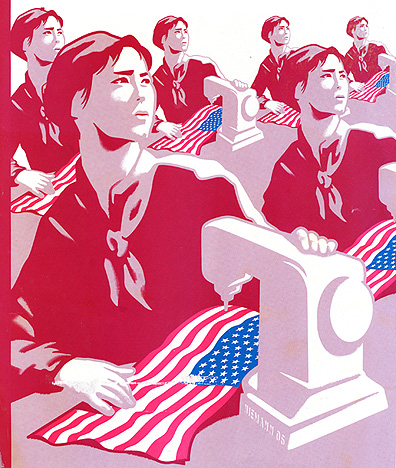 Has the Chinese model triumphed? (art borrowed from the New Yorker) For myself, I’m struck by the convergence that is taking place between the supposedly open and neoliberal U.S. and the authoritarian one-party state that is dabbling with market reforms in China. Some years ago I read this great novel, China Mountain Zhang, wherein Maureen McHugh presents a story set at first in New York in the 2100s, and the world is under the domination of Chinese Marxism-Leninism. She never explains how it got that way, and you just slowly figure out what’s going on from the context of people’s lives. Quite fascinating. And I’d have to say, rather prescient in light of developments.
The U.S. is basically a one-party state in which the media is dutifully the propaganda arm of the government and the corporations that own it. One political Party represents Capital and War and two factions within it (Dems and Repubs) fight for effective power within that logic. Other points of view are systematically exluded through ignoring or ridiculing them, and always dismissed as “unrealistic” or “irrelevant to most people,” in what quickly becomes a self-fulfilling dynamic. The One Party reliably uses the power of government to assure that the personal friends and business associates of the politicians with their hands on the levers of power get the goods, either through tax breaks or government subsidies, and always through institutional support via regulatory and financial bureaucracies. When things go bad (as they are doing) the government rushes to bail out the failed wealthy, arguing publicly that “we’re all in it together”; precisely the opposite rhetoric it uses when its cronies are getting rich during periods of expansion and profitability.
Turns out this is a whole lot like the China that emerged after the death of Mao, when the “capitalist roaders” led by Deng Xiaoping steered the country away from the Stalinist madhouse Mao had pursued for decades. The Chinese Communist Party has enriched its own and their allies, opening up selective property rights to favored friends while using the full power of the police and military to squelch political opposition and social unrest (in spite of this, China has been rocked by thousands of strikes and protests during the past few years). Given the rise of the surveillance state here in the U.S. and the suspension of posse comitatus wherein the military will now be used in domestic repression, I’d say the Bush/Cheneyites have done everything they could to re-engineer U.S. society towards the Chinese model. We’ll see if Obama breaks with this, or just builds on it and exercises even more executive power in the face of the “dire emergency” facing the country now that the house of cards has finally fallen…
It’s all falling down! Like a lot of radicals over the past 30+ years (or is that 130+ years?), I’ve always harbored this deep certainty that the self-perpetuating madness called the capitalist economy would just someday implode… and suddenly, voila! It is!… There’s a lot of lost wealth, already in the trillions, and if some folks are to be believed, a magnitude greater of financial destruction is still ahead. This Doug Noland piece has some really grim numbers to illustrate how profound the collapse is and will be. This blog a friend pointed me to the other day has been pretty impressive too, “The Automatic Earth.” And John Robb, a regular fave of mine, chimes in with this quick and dirty warning. With all this reading I’ve been doing, I have to say I’m rather surprised that the U.S. dollar has strengthened so markedly against almost all other major currencies (excepting the Japanese yen, and the Chinese Yuan), to the point that some of my hedging is actually a horrible failure now. (I stashed a few thou in a “hard currency” fund account and it’s lost about 20% in a few weeks of crashing world economy… who’d a thunk it?) Anyway, here’s a shot of the ruins of old City Hall in San Francisco after the 1906 earthquake, when it was discovered that the 27 years of building had been entirely corrupt, and the walls had been filled with sand… a rather appropriate visual metaphor for what has been done to the system…
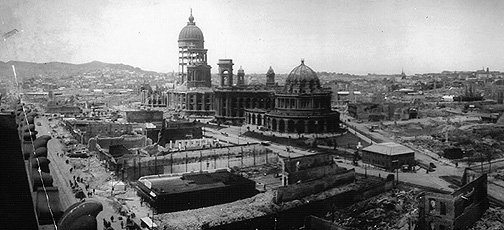 Old City Hall in ruins, San Francisco, 1906. My pals at Retort forwarded these two graphs earlier today, both of which do a good job of quickly illuminating the underlying dynamics at play:
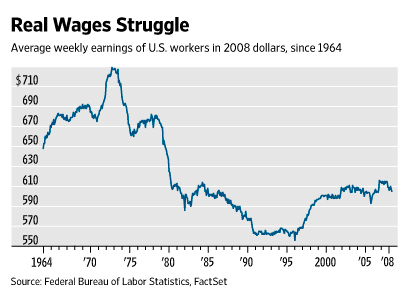
 The Debt Game, Coercion on a grand scale Of course we’re not talking about something “going wrong” here. The systematic expansion of a debt cycle is quite analagous to what was done to the 3rd World in the 1970s, and serves to curb any expectations that life can be other than the bleak and scary world imposed on us by capital. Now all the talk, esp. from the likes of Obama, is about saving the system, unclogging the lines of credit, get things moving again, as though that would be good for average people! The bailout was one of the most egregious public thefts on record, taking billions of dollars of ostensibly public wealth and transferring it to a few failed million- and billionaires, so they can pocket the dough on their way out the door, ensuring decades of gated living and endless rounds of golf as they pass their twilight years lamenting the collapse of the game they’ve been playing all this time. No wonder so many people objected! And little surprise that Obama, bought and paid for by Goldman Sachs and their Chicago Boys ilk, has toed the party line (the One Party line that rules the U.S., the Party of Capital, never mind which faction you lean towards)…
Continue reading Ruins and stuff
So it’s almost done! In fact, both big digital efforts are almost done… this blog got moved, thanks to Cathy at Pajamadon (link at bottom for a bit), who did all the dirty work and helped me get up and running. The Shaping SF wiki is getting there too, a much more daunting project… I’m up to 1017 screens “fixed” with maybe 200 more to go… Been adding a lot of stuff too…
Two worthy events just a week ago: Critical Mass had its Sweet 16th birthday. It was a fine ride, but I can’t say I felt particularly tickled or magical due to the anniversary. The front of the ride went off like a shot, as it has been doing lately, and thus, the ride spread out all over town. Must’ve been between 4,000 and 5,000 cyclists though, so there was quite a large dense pack for a long time. Here’s a few shots:
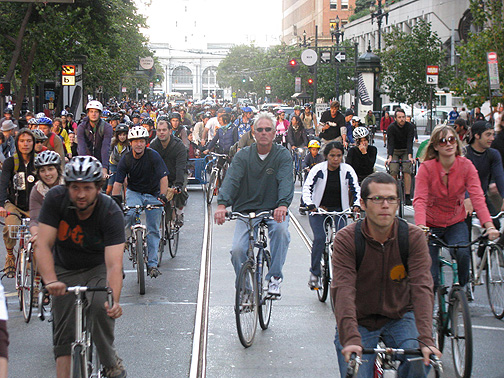 Critical Mass near the beginning of its 16th birthday ride, Sept. 26, 2008.
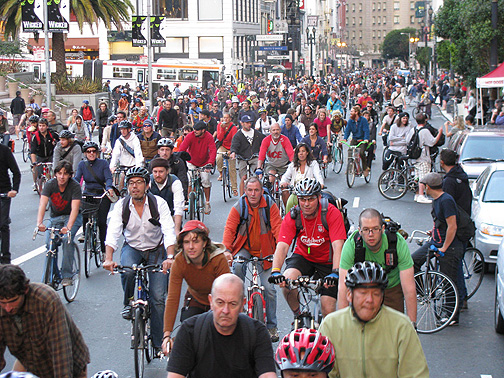 Critical Mass 16th birthday rides past Union Square, San Francisco, Sept. 26, 2008Critical Mass heads south on Polk Street, Sept. 26, 2008.
Continue reading In a New Saddle
|
Hidden San Francisco 2nd EDITION!

NEW 2nd EDITION NOW AVAILABLE!
Buy one here
(Pluto Press, Spring 2025)
|

















